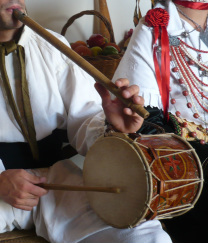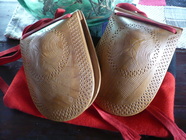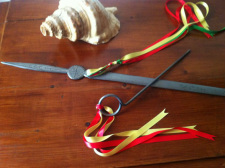OUR MUSIC:
The origens of the Ibicencan folklore music is not know, the antiquity is determined by the instruments used. All instruments wind and percussion are hand made by artisan craftsmen and only materials from the island are used. The instruments are always played by the men.
the drum and the flute.

The drum is the instrument that marks the rhythm, it is made from a hollowed out pine trunk, the sides are either painted or engraved and the top and bottom covered with either lamb, goat or rabbit skins.
The flute has a two hand span more or less and accompanies the drum during the dances and other instrumental parts called “gaites.” Made from oleanders with carved geometrical shapes or plant motifs, it only has three holes, two at the front and one at the back, the mouth piece is made out of wood or tin.
The flute has a two hand span more or less and accompanies the drum during the dances and other instrumental parts called “gaites.” Made from oleanders with carved geometrical shapes or plant motifs, it only has three holes, two at the front and one at the back, the mouth piece is made out of wood or tin.
The castanets.

The castanets must be the most well known and are made from juniper wood, hollowed out to make a louder echo and in the same way as the flutes they are engraved with geometrical shapes or plant motifs. They accompany the dancers, the drum, and the flute in the “gaites.”
the "espasí."

The “espasí” sounds very much like the triangle in an orchestra, it is the only metal instrument played looking like a sword without the hilt it is played with a metal rod.
Other instruments which have been played over the years are the; “xeremia,” used by the shepherds, the “bimbau” and the “calatrec,” these were not played at the dances.
One must mention the Ibicencan song, though never sang during the dances, there are two types, “canço glosada” and “canço redoblada.” The first is a short composition of four improvised verses having a simple but lively melody. The verses are normally made up by various topical issues in an ironic and funny tone.
The song “redoblada,” is a longer composition with a “ieu-ieu” sung after every two verses. Its verses describe a determined theme, and different from the other it is accompanied by the drum.
One must mention the Ibicencan song, though never sang during the dances, there are two types, “canço glosada” and “canço redoblada.” The first is a short composition of four improvised verses having a simple but lively melody. The verses are normally made up by various topical issues in an ironic and funny tone.
The song “redoblada,” is a longer composition with a “ieu-ieu” sung after every two verses. Its verses describe a determined theme, and different from the other it is accompanied by the drum.
